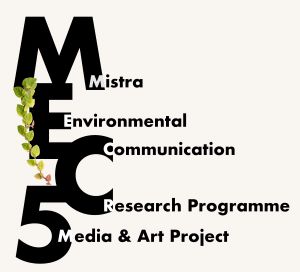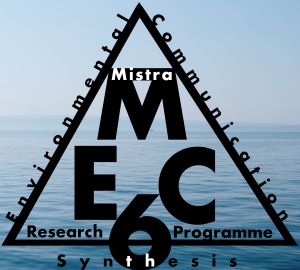This is an archived website, with no changes made after 12 December 2023.
Work Packages
The MISTRA-EC team at the ICSJ of Charles University, led by Nico Carpentier, is involved in several work packages, inclucing the "Environmental communication in (social) media and the arts" work package 5 and the "Synthesis" work package 6.
Media & Art (WP5)

We are interested in the discursive struggles between the different environmental and sustainability discourses that circulate in Swedish arts and media, but we also want to work on developing strategies to open up existing discursive patterns and constellations for a constructive engagement with new or marginalised perspectives.
Arts and media are crucial sites where meanings (and thus discourses) circulate, which makes them unavoidable and necessary to study. But even when they are locations where we can see hegemonic forces at work, privileging dominant ways of thinking about the environment, they also allow for counter-voices, for different ways of thinking, to challenge these dominant ways of thinking.

As there are many different media, we (have to) focus on a selection. We have identified three thematic areas: audio-visual media, social media, and the arts. Even there, we focus more, on television series/serials and documentary film, on blogs, YouTube channels and Facebook groups, and on exhibitions and environmental art projects, always keeping their cross-sections and intersections in mind.
Our research project uses a staged approach, with first a mapping of relevant practices (in the three thematic areas - this is stage 1), followed by six case studies in each of these three thematic areas (stage 2). In stage 3, the results of the case studies will be discussed in feedback loops with their producers. The fourth and final stage communicates the results of the project, but also generates new knowledge, by reverting to a series of transdisciplinary activities in the form of exhibitions, workshops and (video) publications.
In doing so, we're using three bodies of theory. Firstly, we draw on (post-)representational theory and cultural theory to investigate the construction of social and material realities through (social) media and the arts (Burr 2003), including e.g., work on the role of metaphors in the construction of social representations (Selge and Fischer 2011). Secondly, our emphasis on signification and the construction of meaning draws on semiotics and discourse studies (Bignell 1997, Crow 2010, Wodak & Meyer 2016, Van Brussel et al. 2019). Finally, we use theories of materiality, including new materialism (Carpentier 2017) to bring out the role of the material, such as the environment, but also media and arts products and their infrastructures, including the digital materiality of algorithmic information infrastructures (Haider 2016) in environmental communication.
We collaborate with a diversity of societal partners, through a variety of instruments, including sounding boards, video letters, public lectures, unconferences and co-writing. We have also developed an artist-in-residency programme.
At our Videos part of the website, you'll also find a short video presentation on work package 5.
Synthesis (WP6)

The ICSJ team is currently doing two studies in this work package. The first study, on the participatory dimensions of the MEC research programme, examines how the collaborative and participatory activities are perceived and evolve, among the WP5 team members (academic researchers and societal partners). The research will have a specific focus on the power positions of non-academic/societal partners in this process, and the participatory dynamics in a setting where academic and non-academic partners interact and collaborate. The project addresses the conceptual dimension of participation and justice (an explicit part of the synthesis WP6), also touching upon issues related to the other synthesis dimensions - agonistic pluralism, values and emotions, discourses and materialities of communication.
The second study looks how materiality intersects with these discourses on the environment. This is grounded in earlier (theoretical and empirical) work on the Discursive-Material Knot, which develops a non-hierarchical approach to the material and the discursive, to better understand how the materiality of the environment impacts on the ways it is (and can be) discursified. Here, there is a particular interest in how the material can dislocate particular discourses, disrupting them, and/or forcing them into discursive repair. A second entry point is how the material invites, through its own agency, for particular discourses to become assembled with it, rendering the articulation with other discourses more difficult and unlikely.